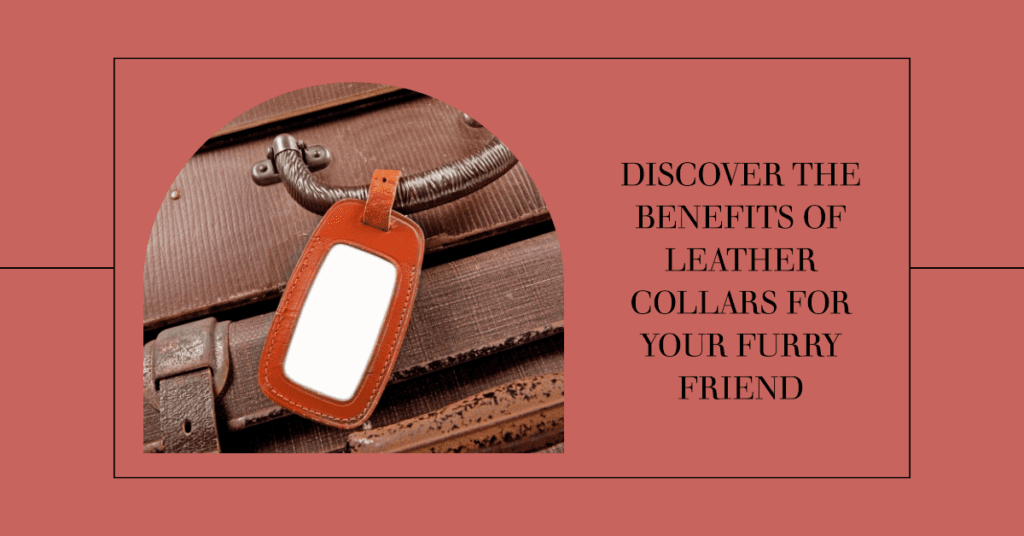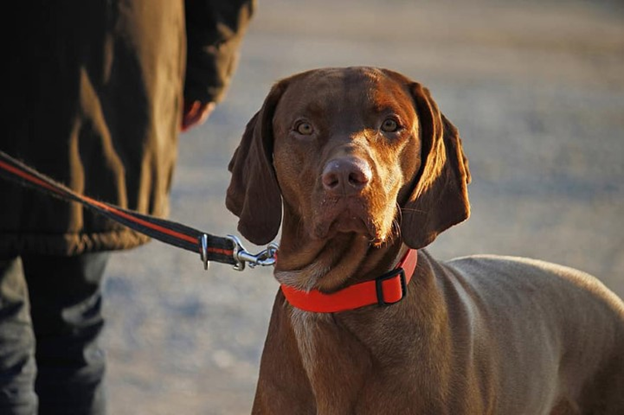One of the questions many new dog owners ask is, “Are leather collars better for dogs?” This article will answer all your burning questions about this popular type of collar.
You know that you need to get a leather collar for your pup and now you're struggling with which brand would be best. To help you through this process we have compiled an extensive list of options so that choosing what type or design is easier than ever before!
We hope that this article will help you make the best decision for your pup.
What does a dog collar do?
A dog collar is a device that encircles the neck of an animal and serves as a means of restraint. It is designed to hold the head up, keep it from rubbing against furniture, and prevent the animal from biting its owner.
Leather collars are a common choice for dogs. However, the material depends on your dog's lifestyle and environment. It is best to choose a collar that will provide comfort, protection from sunburns or rubbing skin lesions, and lightweight materials with low-density foam padding between leather and nylon fabrics to minimize the chafing of an area due to friction.
However, not all breeds of dogs need a collar; some have hair that grows too thick around their neck area to use one without discomfort.
Types of dog collars


Dog collars can be made of various material types, including suede, canvas, metal chains, and even nylon. The type of collar a dog needs is dependent on the size and age of the dog as well as their lifestyle.
The buckle can be metal or plastic depending on preference; however, metal buckles are recommended because of their durability.
The best type of collar will depend on the size and breed of your dog as well as his activities with you throughout the day. Some types of dog collars are as under:-
| Type of Collar | Description |
|---|---|
| Flat Collar | Basic collar made of nylon, leather, or fabric for everyday use. |
| Martingale Collar | Designed to prevent dogs from slipping out; it tightens slightly when the dog pulls. |
| Choke Chain Collar | The slip-style collar that tightens when pulled, is commonly used in training but can be harmful if not used properly. |
| Prong/Pinch Collar | Consists of linked metal prongs that pinch the dog's neck when pulled; used in training with caution. |
| Harness | The slip-style collar that tightens when pulled, commonly used in training but can be harmful if not used properly. |
| Head Collar | Fits around the dog's head, guiding the dog's direction by controlling the head; helpful for strong pullers. |
| GPS/Tracking Collar | Contains a GPS unit to track a dog's location, often used for monitoring and safety during walks or in case the dog gets lost. |
| Flea Collar | Collar infused with chemicals to repel fleas and ticks; provides continuous protection against parasites. |
Types of dog collar material
Leather dog collar
A leather collar is typically made out of cowhide with a variety of colors available for purchase. They are durable and last long periods when cared for properly.
Suede dog collar
Some suede collars are made of patchwork and are typically more luxurious than leather collars.
Nylon dog collar
A nylon collar is made out of a durable, long-lasting material that can withstand harsh weather conditions
Canvas dog collar
A canvas collar is made from a cotton mix or polyester and has been treated with an oil to make it water resistant.
Types of dog collars as per function
Training collars
Training collars are tools for helping with the training of your dog. Each type has its unique features and benefits, but all have one thing in common: they help train your pet.
However, they have the potential to be dangerous because there is no standard set of rules by which obedience practices should take place. The use of training collars in this manner may cause confusion and uncertainty for dog owners and their pets.
Some examples of training collars are choke chains, prong collars, electronic collars (e-collar), and dog shock collars.
Training collars are a form of positive reinforcement. If your dog is not listening, then they will know that something is wrong because the collar sends out an electric stimulation to get their attention.
However, if you don't use the leash correctly or put on a collar in an unsafe manner, your pet can get hurt and so can you!
Martingale dog collar
A martingale dog collar is a type of dog collar that has been used for centuries to train dogs. The design uses a system of knots that tighten when the dog pulls on the collar, which is meant to punish the dog and make it stop.
Martingale dog collars are used to improve the behavior of dogs. They have nylon fabric instead of chain, which is lighter weight. It can be adjusted for your pet's comfort, and it does not slip off easily.
A martingale dog collar has no buckle or clip. It is designed to be pulled tight when the dog pulls, which then loosens as soon as it stops pulling.
The Martingale collar is an effective training method because it prevents dogs from slipping out of their collars as well as relieving pressure on your pup’s neck.
Dog choke chains
A choke chain is a type of dog collar that consists of interconnected rings in the shape of a circle, with each ring bearing two or more links. The purpose of this type of collar is to restrict the dog's ability to move its head and neck. The collar exerts a gentle pressure on the dog's neck that may cause it to stop breathing if pulled too tightly.
Prong or pinch collars
A prong collar is a type of dog collar that makes contact with the neck in three places to prevent the dog from pulling. A pinch collar makes contact with the dog's neck and sits around the dog's neck, keeping pressure on the neck. Therefore, the pinch collar is more constricting than the prong.
Pinch collars are a step further from the choke chain and are not recommended by some because it is more constricting. More so prong collars can be uncomfortable because they rest flush against your dog's neck.
However, you must take guidance from a professionally certified trainer before using any type of collar.
Nylon vs Leather Collars
Nylon is a tough plastic textile, coated with rubber and/or polyurethane that is used for clothing, shoes, and other products. Nylon has a scratch-resistant surface and is not susceptible to mildew. It also won't rot, crack, or peel like leather collars can. Nylon's tensile strength is much greater than that of leather and it does not stretch or tear as easily.
Leather collars are becoming more popular as they provide a durable and stylish option for your canine companion. The material is easy to clean and lasts longer than other materials, which makes it the perfect collar for an active dog that needs protection from scratches or tangles in their fur.
Leather collars are popular because they are durable and provide a healthy life for the dog. Not only do leather collars offer better durability, but they also help keep the pet happy by providing comfort while walking on long walks or going to work.
Leather Collar
- Durable material
- Leather is more expensive than nylon
- Leather can last longer
- More fragile in contact with water
Nylon Collar
- Durable material
- Nylon is better at handling humidity and moisture
- Nylon collars are more adjustable
- Nylon collars work well in rough conditions
Nylon Dog Collars
Nylon collars are made from nylon webbing and have a plastic or metal side release buckle. Nylon collars tend to be less expensive than leather ones, but they don't last as long.
Nylon dog collars are available in a wide range of colors to fit your dog's personality. They come with different levels of toughness, beading, and widths, making them an excellent choice for many dogs.
Nylon dog collars are made of a strong fiber that is durable, lightweight, and comfortable for your pet. It will last for years if you take care of it properly.
Some people prefer nylon collars for their dogs, while others like leather collars. There are some good reasons to choose one type over the other, but ultimately it's a matter of preference.
Nylon can be cheaper and is easier to put on your dog than leather which will take much longer to break in. Nylon also doesn't smell as bad as leather does.
They can be used with dogs who aren't allergic to the nylon material, but if your dog is allergic then you should consider using the leather collar.
Leather Dog Collars For Your Pet
Leather is a great material for dog collars because it's durable and attractive. Many different types of leather collars can be used to suit your needs, likes, or budget.
Leather dog collars can be either flat or rolled. A rolled leather collar is great for long-fur dogs because it prevents matting and curling.
Many companies offer a variety of choices for leather dog collars. They offer standard colors, and padded and non-padded options with various buckles to match your style.
Leather dog collars are traditional and can be a good option for your furry friend. However, they may not last as long if the owner doesn't take care of them.
Leather dog collars are natural materials that don't irritate your dog's neck. These collars are typically made from oils, waxes, and other animal products such as deerskin, elkskin, and buffalo hide.
Are leather collars better for dogs?
Leather collars are far better than nylon ones. This is because they are made of genuine leather, which ensures comfort, protection, and ease of mobility for the dog's neck. It's also important that the collar be made from materials that can provide a comfortable experience for your dog. Using fake leather or other uncomfortable fabrics can be painful for a dog as well.
Leather is durable and lasts longer than other materials. Leather collars are also more comfortable for dogs, who can wear them all the time without irritation. The only downside to these highly-valued leather products is that they're not as cheap as nylon or cloth ones.
Pros and Cons
Pros
- Comfortable and soft material that is sure to provide comfort
- The collar will not rub, irritate, or cause any chafing on your dog's neck
- Easy to clean and maintain with no worry about bacterial growths or odor-causing smells
- It doesn't have any metal parts which can be harmful to dogs' necks
- The natural material allows for more flexibility
- Leather collars are known to have longevity, and typically don't wear out as quickly as other materials
Cons
- The material can be restrictive and not as easy to break free from
- Information on how well it will hold up based on proper care isn't always known
- Often costs more than other materials
- Not everyone likes the look of a leather collar
Many dog experts agree that leather collars are a good choice for your pup
What are the benefits of leather dog collars?
Leather dog collars are made from a specific type of cowhide known as vegetable-tanned leather. The material is very durable and flexible, which makes it the perfect material for a dog collar. The benefits of using leather dog collars are:-
Benefits of leather dog collar
- It's natural, it's earth-friendly
- Leather collars are made of natural materials.
- There's an endless range of materials and styles to choose from.
- Leather collars can be customized in many ways
- Handmade leather collars for dogs are easily available.
- They’re also more comfortable for most canines, and they’re the best choice for a dog with super sensitive skin.
FAQ – Are Leather Collars Better for Dogs
Leather collars are a popular choice for dog owners, but the question of whether they are better for dogs is often on their minds. We gathered some of the most common questions that come up and answered in our FAQ to help you determine if leather collars are right for your furry friend.
What is a dog collar sizing chart?
The sizing chart is a tool that will help you find the best size for your dog.
If your dog needs a new collar, you should use a size chart to find the right one. Depending on their neck size, different types of collars will fit them better and more securely than others.
The best way to keep your pet safe is by selecting an appropriate-sized collar for them so they can’t slip out or hurt themselves in any way while wearing it!
How can you maintain the cleanliness of your dog's collar?
Leather collars are typically the most comfortable option for a dog. However, they require regular care to maintain their quality and keep them clean. For example, you should wipe your dog's collar off with a damp cloth to remove any dirt or mud that has accumulated on it after playing outside. Then use a small amount of mild soap and gently scrub the collar until all traces of soap have been removed. Finally, rub off the soap residue that remains with another wet cloth before applying the leather treatment conditioner to the collar and buffing it dry with a dry cloth.
Are leather collars safe for dogs?
Leather dog collars are considered the best because they're breathable, natural, and organic. This means that your pet doesn't have to deal with chemical preservatives or harsh dyes. Furthermore, these collars are more durable than nylon or cotton ones.
Leather is a great material to use for dog collars because it's eco-friendly and can last years. Leather comes in many colors, each with its benefits for the animal wearing it. Leather must get treated properly so you don't have to worry about your pet getting sick from being exposed to harmful materials or chemicals that might be used on the other side of the collar.
When choosing a type of leather collar, take into account what kind of features are going to be important to your pet. Whether you want a collar that will be easy for them to remove and put on themselves, or one that is durable enough so they don't chew it up immediately, there are many options available at the store.
Do leather collars hurt dogs?
It is not true that leather collars hurt dogs. The basic rule to follow for the proper wearing of a collar is that it should fit snugly around your dog's neck, but not so tight as to cut off circulation and cause injury or discomfort.
The safety of a leather collar is dependent on the design and type. If you choose to buy one, make sure it fits your dog properly and that there are no loose pieces or sharp edges.
What are the benefits of using a leather collar for dogs?
When considering collar material for your dog, both nylon dog collars and leather dog collars are popular choices. However, leather collars are often considered better due to their durability and the comfort they provide for the dog to wear. Leather is a natural material that is gentler on the dog's skin compared to nylon collars.
Are leather collars suitable for all dog breeds?
Leather collars come in a variety of styles and widths, making them suitable for many dog breeds. Whether you have a small puppy or a large breed, you can choose a leather collar that fits your dog comfortably.
How do leather collars compare to nylon collars?
When comparing different types of dog collars, it's important to consider the pros and cons of each. While nylon collars are lightweight and easy to clean, leather collars are durable and offer a classic look that many dog owners appreciate.
What type of dog collar is best for training?
For training purposes, a flat leather collar or a rolled leather collar can be best for your dog. These types of collars provide gentle control without putting too much pressure on the dog's neck when the dog pulls.
How can I choose the best leather collar for my dog?
When choosing a collar for your pet, consider the quality of leather used, the buckle type, the width and thickness of the collar, and the overall design and style. It's important to choose a collar made of durable, high-quality leather to ensure it will last a long time and not cause any discomfort to your pet.
The buckle type should be easy to use and secure, such as a durable metal buckle. The width and thickness of the collar should be appropriate for your pet's size and breed, providing enough support without being too bulky. Lastly, consider the overall design and style of the collar to ensure it reflects your pet's personality and fits their individual needs.
Conclusion
Leather collars are a great option for dogs, but in the end, it is up to you and your dog. The good thing about leather collars is they don't have any plastic components that could potentially cause harm to your dog's health.
Leather collars have their advantages. They're stylish and comfortable for your dog as well. However, you should be aware that there are other materials to choose from like nylon or neoprene collars which we've reviewed in another article here on our blog!
The best part is that it's up to you what type of collar your pup has so don't feel pressured by anyone who tells you a certain kind is better than others because they might not know all the information!





